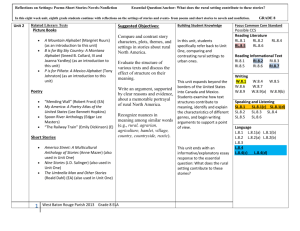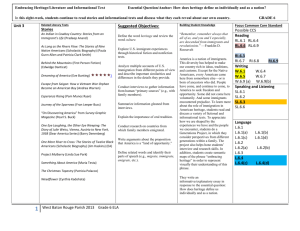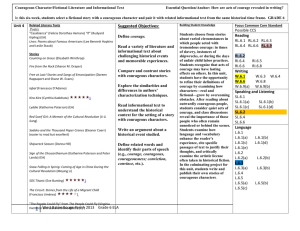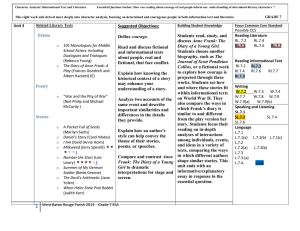CCSS Unit 6 Gr8 ELA DHenry
advertisement
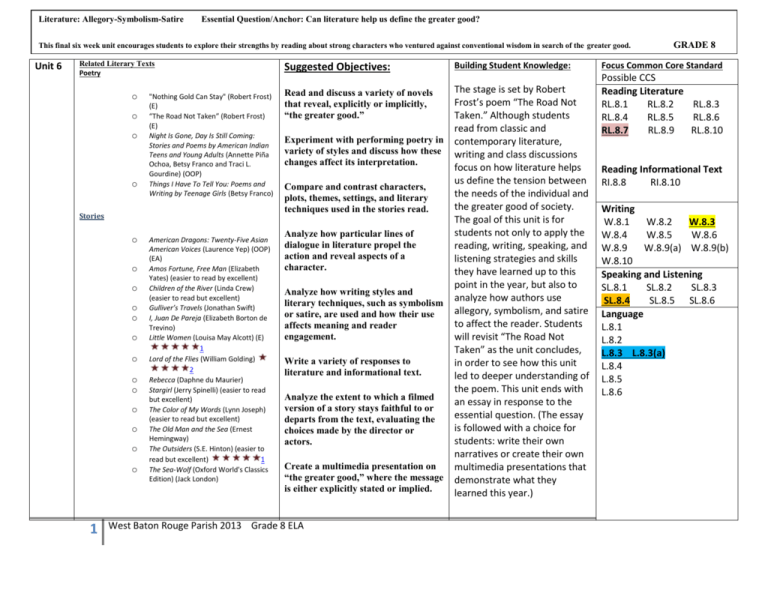
Literature: Allegory-Symbolism-Satire Essential Question/Anchor: Can literature help us define the greater good? This final six week unit encourages students to explore their strengths by reading about strong characters who ventured against conventional wisdom in search of the greater good. Unit 6 Related Literary Texts Poetry o o o o "Nothing Gold Can Stay" (Robert Frost) (E) “The Road Not Taken” (Robert Frost) (E) Night Is Gone, Day Is Still Coming: Stories and Poems by American Indian Teens and Young Adults (Annette Piña Ochoa, Betsy Franco and Traci L. Gourdine) (OOP) Things I Have To Tell You: Poems and Writing by Teenage Girls (Betsy Franco) Stories o o o o o o o o o o o o o 1 American Dragons: Twenty-Five Asian American Voices (Laurence Yep) (OOP) (EA) Amos Fortune, Free Man (Elizabeth Yates) (easier to read by excellent) Children of the River (Linda Crew) (easier to read but excellent) Gulliver’s Travels (Jonathan Swift) I, Juan De Pareja (Elizabeth Borton de Trevino) Little Women (Louisa May Alcott) (E) 1 Lord of the Flies (William Golding) 2 Rebecca (Daphne du Maurier) Stargirl (Jerry Spinelli) (easier to read but excellent) The Color of My Words (Lynn Joseph) (easier to read but excellent) The Old Man and the Sea (Ernest Hemingway) The Outsiders (S.E. Hinton) (easier to read but excellent) 1 The Sea-Wolf (Oxford World's Classics Edition) (Jack London) Suggested Objectives: Building Student Knowledge: Read and discuss a variety of novels that reveal, explicitly or implicitly, “the greater good.” The stage is set by Robert Frost’s poem “The Road Not Taken.” Although students read from classic and contemporary literature, writing and class discussions focus on how literature helps us define the tension between the needs of the individual and the greater good of society. The goal of this unit is for students not only to apply the reading, writing, speaking, and listening strategies and skills they have learned up to this point in the year, but also to analyze how authors use allegory, symbolism, and satire to affect the reader. Students will revisit “The Road Not Taken” as the unit concludes, in order to see how this unit led to deeper understanding of the poem. This unit ends with an essay in response to the essential question. (The essay is followed with a choice for students: write their own narratives or create their own multimedia presentations that demonstrate what they learned this year.) Experiment with performing poetry in variety of styles and discuss how these changes affect its interpretation. Compare and contrast characters, plots, themes, settings, and literary techniques used in the stories read. Analyze how particular lines of dialogue in literature propel the action and reveal aspects of a character. Analyze how writing styles and literary techniques, such as symbolism or satire, are used and how their use affects meaning and reader engagement. Write a variety of responses to literature and informational text. Analyze the extent to which a filmed version of a story stays faithful to or departs from the text, evaluating the choices made by the director or actors. Create a multimedia presentation on “the greater good,” where the message is either explicitly stated or implied. West Baton Rouge Parish 2013 Grade 8 ELA GRADE 8 Focus Common Core Standard Possible CCS Reading Literature RL.8.1 RL.8.2 RL.8.3 RL.8.4 RL.8.5 RL.8.6 RL.8.7 RL.8.9 RL.8.10 Reading Informational Text RI.8.8 RI.8.10 Writing W.8.1 W.8.2 W.8.3 W.8.4 W.8.5 W.8.6 W.8.9 W.8.9(a) W.8.9(b) W.8.10 Speaking and Listening SL.8.1 SL.8.2 SL.8.3 SL.8.4 SL.8.5 SL.8.6 Language L.8.1 L.8.2 L.8.3 L.8.3(a) L.8.4 L.8.5 L.8.6 Informational Texts Literary Criticism “Robert Frost, Poet of Action” (James McBride Dabbs) Nonfiction Trek 7, and The Fractal Pond Race (from Math Trek: Adventures in the Math Zone (Ivars Peterson and Nancy Henderson) (E) Art, Music and Media Art o o Film o o o o o o Unit 6: Artemisia Gentileschi, Self-Portrait as the Allegory of Painting (1638-1639) Diego Velázquez, Juan de Pareja (1650) Charles Sturridge, dir., Gulliver’s Travels (1996) Gillian Armstrong, dir., Little Women (1994) John Sturges, dir., The Old Man and the Sea (1958) Jud Taylor, dir., The Old Man and the Sea (1990) Mervyn LeRoy, dir., Little Women (1949) Michael Curtiz, dir., The Sea Wolf (1941) Terminology: Allegory Symbolism 2 Hero/Heroine Style West Baton Rouge Parish 2013 Grade 8 ELA Satire Strength of Character Weeks 31-36 Grade 8 Unit 6 Literature: Allegory-Symbolism-Satire “I CAN” Statements Standards for Unit 6 Reading Literature RL.8.1 Read closely to determine what the text says explicitly and to make logical inferences from it; cite specific textual evidence when writing or speaking to support conclusions drawn from the text. RL.8.2 Determine central ideas or themes of a text and analyze their development; summarize the key supporting details and ideas. RL.8.3 Analyze how and why individuals, events, and ideas develop and interact over the course of a text. RL.8.4 Interpret words and phrases as they are used in a text, including determining technical, connotative, and figurative meanings, and analyze how specific word choices shape meaning or tone. I can cite textual evidence to support analysis of what the text says explicitly. I can make inferences drawn from the text. I can determine a theme or central idea of a text and analyze its development over the course of the text, including its relationship to the characters, setting and plot. I can provide an objective summary of the text. I can analyze how particular lines of dialogue or incidents in a story or drama propel the action, reveal aspects of a character, or provoke a decision. I can determine the meaning of words and phrases as they are used in a text, including figurative and connotative meanings. I can analyze the impact of specific word choices on meaning and tone, including analogies or allusions to other texts. RL.8.5 Analyze the structure of texts, including how specific sentences, paragraphs, and larger portions of the text (e.g., a section, chapter, scene, or stanza) relate to each other and the whole. I can compare and contrast the structure of two or more texts. I can analyze how the differing structure of each text contributes to its meaning and style. RL.8.6 Assess how point of view or purpose shapes the content and style of a text. FOCUS STANDARD RL.8.7 Integrate and evaluate content presented in diverse media and formats, including visually and quantitatively, as well as in words. I can analyze how differences in the points of view of the characters and the audience or reader (e.g., created through the use of dramatic irony) create such effects as suspense or humor. I can analyze the extent to which a filmed or live production of a story or drama stays faithful to or departs from the text or script. I can evaluate the choices made by the director or actors. 3 West Baton Rouge Parish 2013 Grade 8 ELA RL.8.9 Analyze how two or more texts address similar themes or topics in order to build knowledge or to compare the approaches the authors take. I can analyze how a modern work of fiction draws on themes, patterns of events, or character types from myths, traditional stories, or religious works such as the Bible, including describing how the material is rendered new. RL.8.10 Read and comprehend complex literary and informational texts independently and proficiently. I can read and comprehend literature, including stories, dramas, and poems, at the high end of grade 8 text complexity band independently and proficiently. Reading Informational Text RI.8.8 Delineate and evaluate the argument and specific claims in a text, including the validity of the reasoning as well as the relevance and sufficiency of the evidence. RI.8.10 Read and comprehend complex literary and informational texts independently and proficiently. Writing FOCUS STANDARD W.8.1 Write arguments to support claims in an analysis of substantive topics or texts, using valid reasoning and relevant and sufficient evidence. I can delineate and evaluate the argument and specific claims in a text, assessing whether the reasoning is sound and the evidence is relevant and sufficient. I can recognize when irrelevant evidence is introduced. I can read and comprehend literary nonfiction at the high end of the grade 8 text complexity band independently and proficiently. I can write arguments to support claims with clear reasons and relevant evidence. I can introduce claim(s), acknowledge alternate or opposing claims, and organize the reasons and evidence logically. I can support claim(s) with logical reasoning and relevant evidence, using accurate, credible sources and demonstrating an understanding of the topic or text. I can use words, phrases, and clauses to create cohesion and clarify the relationships among claim(s), reasons, and evidence. I can establish and maintain a formal style. I can provide a concluding statement or section that follows from and supports the argument presented. 4 West Baton Rouge Parish 2013 Grade 8 ELA W.8.2 Write informative/explanatory texts to examine and convey complex ideas and information clearly and accurately through the effective selection, organization, and analysis of content. I can write informative/explanatory texts to examine a topic and convey ideas, concepts, and information through the selection, organization, and analysis of relevant content. I can introduce a topic clearly, previewing what is to follow; organize ideas, concepts, and information into broader categories; include formatting (e.g., headings), graphics (e.g., charts, tables), and multimedia when useful to aiding comprehension. I can develop the topic with relevant, well-chosen facts, definitions, concrete details, quotations, or other information and examples. I can use appropriate and varied transitions to create cohesion and clarify the relationships among ideas and concepts. I can use precise language and domain-specific vocabulary to inform about or explain the topic. I can establish and maintain a formal style. I can provide a concluding statement or section that follows from and supports the information or explanation presented. FOCUS STANDARD W.8.3 Write narratives to develop real or imagined experiences or events using effective technique, well-chosen details, and well-structured event sequences. I can write narratives to develop real or imagined experiences or events using effective technique, relevant descriptive details, and well-structured event sequences. I can engage and orient the reader by establishing a context and point of view and introducing a narrator and/or characters; organize an event sequence that unfolds naturally and logically. I can use narrative techniques, such as dialogue, pacing, description, and reflection, to develop experiences, events, and/or characters. I can use a variety of transition words, phrases, and clauses to convey sequence, signal shifts from one time frame or setting to another, and show the relationships among experiences and events. I can use precise words and phrases, relevant descriptive details, and sensory language to capture the action and convey experiences and events. 5 West Baton Rouge Parish 2013 Grade 8 ELA I can provide a conclusion that follows from and reflects on the narrated experiences or events. W.8.4 Produce clear and coherent writing in which the development, organization, and style are appropriate to task, purpose, and audience. I can produce clear and coherent writing in which the development, organization, and style are appropriate to task, purpose, and audience. W.8.5 Develop and strengthen writing as needed by planning, revising, editing, rewriting, or trying a new approach. I can with some guidance and support from peers and adults, develop and strengthen writing as needed by planning, revising, editing, rewriting, or trying a new approach, focusing on how well purpose and audience have been addressed. I can use technology, including the Internet, to produce and publish writing and present the relationships between information and ideas efficiently as well as to interact and collaborate with others I can draw evidence from literary or informational texts to support analysis, reflection, and research. W.8.6 Use technology, including the Internet, to produce and publish writing and to interact and collaborate with others. W.8.9 Draw evidence from literary or informational texts to support analysis, reflection, and research. I can apply grade 8 Reading standards to literature (e.g., “Analyze how a modern work of fiction draws on themes, patterns of events, or character types from myths, traditional stories, or religious works such as the Bible, including describing how the material is rendered new”). I can apply grade 8 Reading standards to literary nonfiction (e.g., “Delineate and evaluate the argument and specific claims in a text, assessing whether the reasoning is sound and the evidence is relevant and sufficient; recognize when irrelevant evidence is introduced”). W.8.10 Write routinely over extended time frames (time for research, reflection, and revision) and shorter time frames (a single sitting or a day or two) for a range of tasks, purposes, and audiences. 6 West Baton Rouge Parish 2013 Grade 8 ELA I can write routinely over extended time frames (time for research, reflection, and revision) and shorter time frames (a single sitting or a day or two) for a range of discipline-specific tasks, purposes, and audiences. Speaking and Listening SL.8.1 Prepare for and participate effectively in a range of conversations and collaborations with diverse partners, building on others‟ ideas and expressing their own clearly and persuasively I can engage effectively in a range of collaborative discussions (one-on-one, in groups, and teacher-led) with diverse partners on grade 8 topics, texts, and issues, building on others‟ ideas and expressing their own clearly. I can come to discussions prepared, having read or researched material under study. I can explicitly draw on that preparation by referring to evidence on the topic, text, or issue to probe and reflect on ideas under discussion. I can follow rules for collegial discussions and decision-making, track progress toward specific goals and deadlines, and define individual roles as needed. I can pose questions that connect the ideas of several speakers and respond to others‟ questions and comments with relevant evidence, observations, and ideas. I can acknowledge new information expressed by others, and, when warranted, qualify or justify their own views in light of the evidence presented. SL.8.2 Integrate and evaluate information presented in diverse media and formats, including visually, quantitatively, and orally. I can analyze the purpose of information presented in diverse media and formats (e.g., visually, quantitatively, orally) and evaluate the motives (e.g., social, commercial, political) behind its presentation. SL.8.3 Evaluate a speaker’s point of view, reasoning, and use of evidence and rhetoric. I can delineate a speaker’s argument and specific claims, evaluating the soundness of the reasoning and relevance and sufficiency of the evidence and identifying when irrelevant evidence is introduced. FOCUS STANDARD SL.8.4 Present information, findings, and supporting evidence such that listeners can follow the line of reasoning and the organization, development, and style are appropriate to task, purpose, and audience 7 West Baton Rouge Parish 2013 Grade 8 ELA I can present claims and findings, emphasizing salient points in a focused, coherent manner with relevant evidence, sound valid reasoning, and wellchosen details; use appropriate eye contact, adequate volume, and clear pronunciation. SL.8.5 Make strategic use of digital media and visual displays of data to express information and enhance understanding of presentations. I can integrate multimedia and visual displays into presentations to clarify information, strengthen claims and evidence, and add interest. SL.8.6 Adapt speech to a variety of contexts and communicative tasks, demonstrating command of formal English when indicated or appropriate. Language L.8.1 Demonstrate command of the conventions of standard English grammar and usage when writing or speaking. I can adapt speech to a variety of contexts and tasks, demonstrating command of formal English when indicated or appropriate. I can demonstrate command of the conventions of standard English grammar and usage when writing or speaking. I can explain the function of verbals (gerunds, participles, infinitives) in general and their function in particular sentences. I can form and use verbs in the active and passive voice. I can form and use verbs in the indicative, imperative, interrogative, conditional, and subjunctive mood. I can recognize and correct inappropriate shifts in verb voice and mood.* L.8.2 Demonstrate command of the conventions of standard English capitalization, punctuation, and spelling when writing. I can demonstrate command of the conventions of standard English capitalization, punctuation, and spelling when writing. I can use punctuation (comma, ellipsis, dash) to indicate a pause or break. I can use an ellipsis to indicate an omission. I can spell correctly. L.8.3 Apply knowledge of language to understand how language functions in different contexts, to make effective choices for meaning or style, and to comprehend more fully when reading or listening. I can use knowledge of language and its conventions when writing, speaking, reading, or listening. I can use verbs in the active and passive voice and in the conditional and subjunctive mood to achieve particular effects (e.g., emphasizing the actor or the action; expressing uncertainty or describing a state contrary to fact). L.8.4 Determine or clarify the meaning of unknown and multiple-meaning words and phrases by using context clues, analyzing meaningful word parts, and consulting general and specialized reference materials, as 8 West Baton Rouge Parish 2013 Grade 8 ELA I can determine or clarify the meaning of unknown and multiple-meaning words or phrases based on grade 8 reading and content, choosing flexibly appropriate. from a range of strategies. I can use context (e.g., the overall meaning of a sentence or paragraph; a word‟s position or function in a sentence) as a clue to the meaning of a word or phrase. I can use common, grade-appropriate Greek or Latin affixes and roots as clues to the meaning of a word (e.g., precede, recede, secede). I can consult general and specialized reference materials (e.g., dictionaries, glossaries, thesauruses), both print and digital, to find the pronunciation of a word or determine or clarify its precise meaning or its part of speech. I can verify the preliminary determination of the meaning of a word or phrase (e.g., by checking the inferred meaning in context or in a dictionary). L.8.5 Demonstrate understanding of word relationships and nuances in word meanings. I can demonstrate understanding of figurative language, word relationships, and nuances in word meanings. I can interpret figures of speech (e.g. verbal irony, puns) in context. I can use the relationship between particular words to better understand each of the words. L.8.6 Acquire and use accurately a range of general academic and domain specific words and phrases sufficient for reading, writing, speaking, and listening at the college and career readiness level; demonstrate independence in gathering vocabulary knowledge when encountering an unknown term important to comprehension or expression. 9 West Baton Rouge Parish 2013 Grade 8 ELA I can distinguish among the connotations (associations) of words with similar denotations (definitions) (e.g., bullheaded, willful, firm, persistent, resolute I can acquire and use accurately grade-appropriate general academic and domain-specific words and phrase. I can gather vocabulary knowledge when considering a word or phrase important to comprehension or expression.
